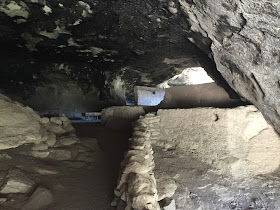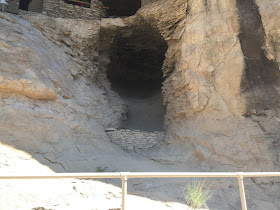Well it's been a while since our last blog, but we have been very busy working at Amazon in Campbellsville, KY for their peak season just before Christmas. It seems like a blur now, but we worked there for three hard months and it took all of our time.
So now since that is over we would first like to wish everyone a Very Merry Christmas and Happy New Year! May the holidays be special and all your gifts be good. Also remember Christ is the most important thing about Christmas.
 |
| Jesus Christ in the manger. |
Working at Amazon is not for everyone since you are on your feet for ten to twelve hours a day, fifty to sixty hours a week. You do get used to it so that by the end of your tour, you can actually sit down and get back up without your muscles locking up on you, unlike when you first started to work there.
We will probably never work at Amazon again since it just does not suit us, but I guess you should never say never. The worst thing for us was the time away from home. It was not so bad when it was four ten hour days and you had three days off, but when it switched to five ten hours day, with only two days off, it did not leave you much time to relax.
 |
| Amazon CamperForce Logo. |
If you would be interested in working at Amazon then you can check out what jobs are available at their CamperForce page. The CamperForce program is where they recruit RVers to help them during the holiday rush. Check it out and see if you want to become an Amazon CamperForce Associate.
Shaker Village of Pleasant Hill
While in the Campbellsville, KY area we had a chance to visit the Shaker Village of Pleasant Hill which was a glimpse into the past.
We call them Shakers, but their real name is The United Society of Believers in Christ's Second Appearing, which is a mouth full. The rest of the world started calling them "Shaking Quakers" or "Shakers" for short.
Their founder was Mother Ann Lee who lived in Manchester England and brought eight followers over to America in 1774 in search of religious freedom.
While there we ate lunch at The Trustee's Table restaurant and was not unimpressed. Walk-ins are accepted, but we had to make our reservation a week out, so unless you want to wait, make reservations. The food is simple, but delicious.
 |
| Pork Loin with gravy, green beans, corn pudding, and cranberry sauce. |
After eating lunch we took a guided tour of the village which was not quite as long or informative as I would have liked, but it was cold and I think our tour guide wanted inside more than outside.
Most buildings had two doors in front so that the Shaker men could enter in on the east side while the Shaker women used the doors on the west side of the building. That is also how they lived in all of the houses. Women lived together on the west side while men lived together on the east side of the house.
 |
| Centre Family Dwelling |
The inside of the house is exactly the same with one side for the men and the other side for the women. Since they practiced celibacy each sex lived on their side.
 |
| East and West entry doors to Centre Family Dwelling. |
 |
| Mirror image inside of the house. One side for men the other side for woman. |
 |
| Stairs for both men and woman in the house. |
We are not sure whether or not they could mingle together in the common or meeting room in the house, but there was one such room in each house.
 |
| Meeting room in Centre Family Dwelling. |
One neat thing I saw while in the house which has exhibits in every room and on every wall is the four steps required to weave a basket. This may be something we will try with the kids one day for homeschool.
 |
| The four steps required to weave a basket. |
When they first established the village they built a little community house that only had one door. Not sure when the duplex house complex came about but this first one seemed to be a regular type house other than it was communal too. We did not get to go inside of it though.
 |
| First communal house at Shaker Village of Pleasant Hill. |
The Trustee's Office is where the restaurant and hotel are but used to be where the trustees of the village worked. It also provided lodging for visitors to the village. To show some of the Shaker handiwork it contains twin spiral staircases built by Micajah Burnett who was one of the main architects for the community.
 |
| Ready for Christmas. |
 |
| Courtney looking down the spiral stairs from the second floor. |
 |
| Looking down from the second story. |
 |
| Looking down from the third story. |
 |
| Looking down form the very top of the spiral stairs. |
During its peak around 1823 the village boasted 491 residents with 4500 acres, and 260 structures to include a municipal water system which was one of the earliest ones in Kentucky at that time.
 |
| Looking west on the main turnpike through the village. |
 |
| Looking east on the main turnpike through the village. |
 |
| Looking out the east side of the Centre Family Dwelling. |
 |
| Looking east toward the west side of the Centre Family Dwelling. |
One of the main buildings in the village was the Meeting House which was in the center of the community and housed all of the worship services where the Shakers would shake, whirl and twirl from which their nickname came from.
 |
| Meeting House where worship services were held. |
 |
| Inside the Meeting House looking through the Ministry team window. |
During worship services, non Shakers would sit on the benches that run along the walls. The ministry team would look through a little window located in the front corners of the big room and see if any of the non Shakers showed any type of interest in the service. If they tapped their feet or moved with the singing, then they would be approached as a possible recruit into the Shaker way of life.
 |
| Window used by Ministry team to observe non Shakers during worship service. |
 |
| Big open room so the Shakers could shake and whirl during worship services. |
I guess that the Shaker way of life is not lived that much by anyone, anymore since the only remaining working Shaker village still in existence is in Maine at Sabbathday Lake and only has three residents.
I'm not sure why they did not make it, but maybe the vow of celibacy was the cause. They were and are a good group of Christian believing people who had a great work ethic. They practiced loving one another and doing good works.
We had fun on our historic tour of the village and it was nice to get out and see some sights after working so long at Amazon.
 |
| Misty, Tia, Avery, Ian, Courtney, Ethan, and Chloe at Shaker Village of Pleasant Hill. |
 |
| Tia, Don, Avery, Courtney, Ian, Ethan, and Chloe at Shaker Village of Pleasant Hill. |
Merry Christmas and Happy New Year too! We are blessed and thank God for all of our blessings. May you be blessed and may God help you with anything that you can not handle. He will give you the strength you need, if you just ask.
If you have not signed up to follow our blog, please do so now. Also if you want to be our friends, on Facebook, do that too.
Thanks!
Don, Misty, and Kids...
 |
| States we have visited so far. |








































































